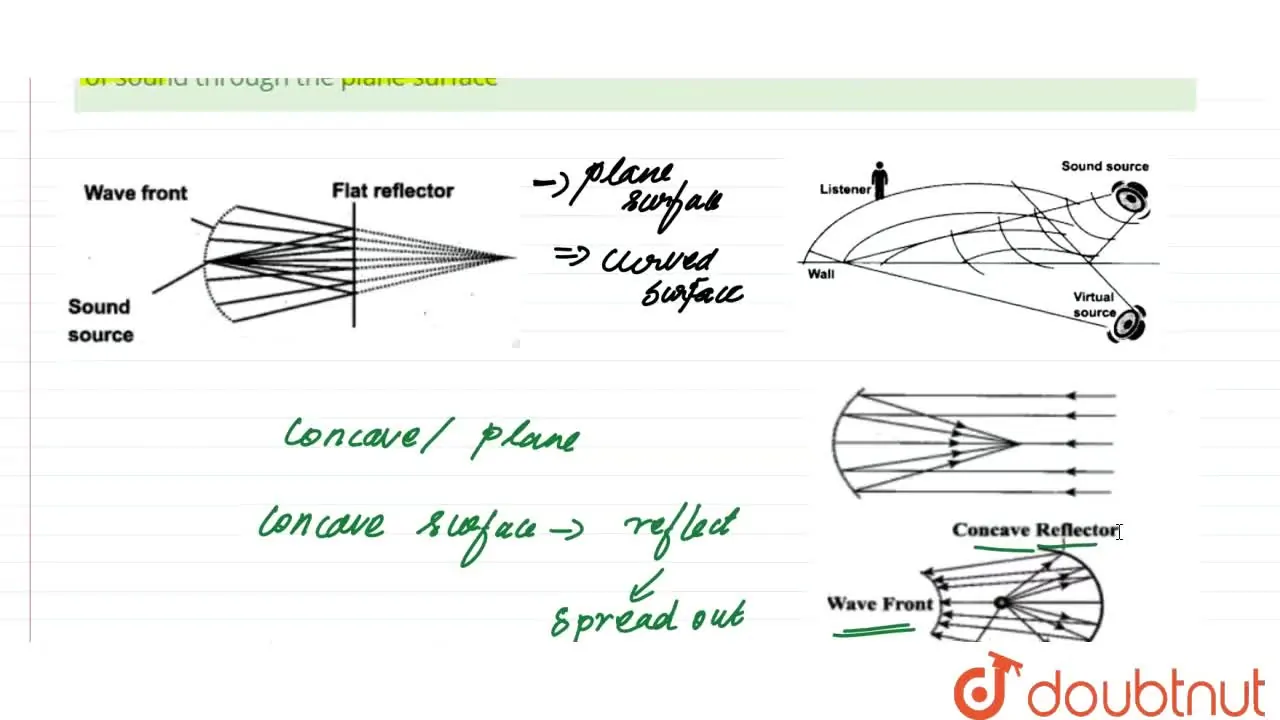Write short notes on reflection of sound waves from plane and curved surfaces. Reflection of sound through the plane surface Solution in Tamil
Sound reflects from a harder flat surface, is called as specular reflection.
Specular reflection is observed only when the wavelength of the source is smaller than dimensions of the reflecting surface, as well as smaller than surface irregularities.
When the sound waves hit the plane wall, they bounce off in manner similar to that of light. Suppose a loudspeaker is kept at an angle with respect to a wall (plane surface), then the waves coming from the source (assumed to be a point source) can be treated as spherical wave front). Therefore, the reflected wave front on the plane surface is also spherical, such that its centre of curvature (which lies on the other side of plane surface) can be treated as the image of the sound source (virtual or imaginary loud speaker) which can be assumed to be at a position behind the plane surface.

Reflection of sound through the curved surface
The behaviour of sound is different when it is reflected from different surfaces-convex or concave or plane The sound reflected from a convex surface is spread out and so it is easily attenuated and weakened. Whereas, if it is reflected from the concave surface it will converge at a point and this can be easily amplified. The parabolic reflector (curved reflector) which is used to focus the sound precisely to a point is used in designing the parabolic mics which are known as directional microphones. We know that any surface (smooth or rough) can absorb sound.
Related Playlists
- BOOK - SURA PUBLICATIONCHAPTER - WAVES EXERCISE - NUMERICAL PROBLEMS:13videos
WAVES
- BOOK - SURA PUBLICATIONCHAPTER - WAVES EXERCISE - CONCEPTUAL QUESTIONS:6videos
WAVES
- BOOK - SURA PUBLICATIONCHAPTER - WAVES EXERCISE - VALUE BASED QUESTIONS2videos
WAVES
- BOOK - SURA PUBLICATIONCHAPTER - SURAS MODEL QUESTION PAPER -2 ( PHYSICS )EXERCISE - PART - IV10videos
SURAS MODEL QUESTION PAPER -2 ( PHYSICS )
- BOOK - SURA PUBLICATIONCHAPTER - WORK, ENERGY AND POWER EXERCISE - VALUE BASED QUESTIONS5videos
WORK, ENERGY AND POWER
Similar Questions
The speed of a wave in a certain medium is 900 m/s. If 3000 waves passes over a certain point of the medium in 2 minutes, then compute its wavelength.
01:46View SolutionWhy is it that transverse waves cannot be produced in a gas? Can the transverse waves be produced in solids and liquids?
02:07View Solution(i) What is the science (physics concept) behind a stethoscope? What is the principle?
(ii) How will you make a child to understand the, Intensity of light or sound From Density without using formulae.05:01View SolutionWrite the expression for the veloctiy of longitudinal waves in an elastic medium.
02:53View SolutionRamu and Raju are dragging water in a bucket from the wells A and B respectively. Ramu dragged three buckets of water within 5 minutes but Raju could not do for the short interval of time. He could take only two buckets of water in 7 minutes. What do you inter from this Incidence.
What is the Expression for Work or Energy ?07:47View SolutionThe direction of an incident sound wave makes an angle of 30^(@) with the normal of a reflecting surface The reflected sound wave makes an angle of _______ with the normal.
12:38View SolutionA sound wave makes an angle 30^(@) with the reflecting surface. The angle of reflection is _______.
08:28View SolutionWhen sound waves are reflected from a denser medium
03:57View SolutionWrite the application of reflection of sound though the be curved surface.
01:21View SolutionUsing Huygens principle, show that the angle of incidence is equal to angle of reflection during a plane wave front reflected by a plane surface.
01:31View Solutionहाइगेंस सिध्दांत का उपयोग करते हुए समतल पृष्ठ से एक समतल तरंग का परावर्तन की व्याख्या कीजिये ।
40:49View SolutionWrite short notes on reflection of sound waves from plane and curved surface.
02:07View SolutionWrite short notes on reflection of sound waves from plane and curved surfaces. Reflection of sound through the plane surface
01:46View Solutionएक ध्वनि तरंग परावर्ती वस्तु की सतह पर लम्बवत् टकराती है। परावर्तन कोण का मान है
02:07View Solutionएक ध्वनि तरंग परावर्ती पृष्ठ से 70° कोण पर टकराती है। आपतित एवं परावर्तित ध्वनि तरंगों के बीच कोण होगा।
02:31View Solution


